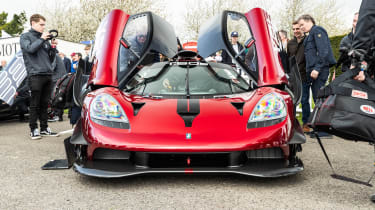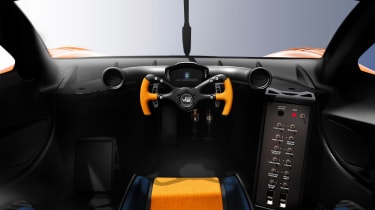£3.1m GMA T.50s makes public debut at Goodwood Members' Meeting
Gordon Murray’s T.50 supercar gets more power and more downforce in track-only form, and it's now made its public debut at the 81st Goodwood Members' Meeting
The brief was clear for the GMA T.50 – Gordon Murray wanted to design the ultimate driver’s car, a visceral, distraction-free on-road experience that would constitute a swan-song for the combustion-engined automobile. The track-only T.50s Niki Lauda is part two of that project, with a similar technical package but a different ethos underpinning it. For the first time since its 2021 reveal, the model has hit the track at the 81st Goodwood Members' Meeting for a stunning public debut.
The GMA T.50s Niki Lauda is more than just a bewinged, track-only variant of the T.50. Rather it is an alternative interpretation of Murray’s vision that’s just as finely crafted and arguably even more exciting. The T.50s was always part of the plan for GMA, the additional 25 units factored in on top of the 100-strong run for the road-going T.50. The two variants, unsurprisingly, share many of their key components, but with no regulations to be confined by, Murray and his team at GMA have been able to push the T.50s’s development further, resulting in a supercar with more power, less weight and considerably more on-track performance.
In fact, Murray is so confident in this track-focused variant’s abilities that he’s seen fit to name it in tribute to one of the most successful Formula 1 drivers of all-time, Niki Lauda. The model’s launch date – 22 February – even coincided with the three-time F1 champion’s birthday.
Priced from £3.1m before local taxes, the T.50s will be a ‘turn up and go’ style of track car, without the need for any technicians or support crew to be present for it to be driven. Each example will be sold with all the tools and support hardware required to run it at a track event.
Engine and transmission
Starting under its new rear clamshell, the 3.9-litre V12 engine has received a substantial set of changes from engine builder Cosworth. These include a new cylinder head and camshafts, and a higher compression ratio of 15:1, plus the removal of the standard V12’s variable valve timing. Peak power is now rated at 725bhp at 11,500rpm, 71bhp more than the road-going T.50, and torque is also up, albeit very marginally, to 347lb ft at 9500rpm (+2lb ft).
With a host of lightweighting measures within the engine, the V12’s overall weight has been reduced to just 162kg, 16kg less than the T.50-spec unit that was already the lightest non-competition V12 ever. The intake and exhaust systems have been completely redesigned, too. The former features a new ram induction system to force more air into the engine, while the exhaust is a new catalyst-free, straight-through design made of Inconel and exits lower down, between the diffuser’s venturi tunnels instead of either side of the rear-mounted fan.
From a philosophical perspective, the biggest change between the T.50 and T.50s is the transmission. Gone is the six-speed manual, in its place a six-speed Instantaneous Gearshift (ISG) semi-automatic gearbox from Xtrac. Despite only having a single clutch, the transmission’s pre-selector design claims to yield the instantaneous shifts of a dual-clutch unit, yet without the associated weight. The gearbox’s mechanisms are also electronically rather than hydraulically driven, further reducing complexity and also even more weight.
Chassis
The carbonfibre tub is mostly familiar from the T.50 road car, with only fixings, carriers and other supplementary changes required to support the track car’s differences. The T.50s also runs the same basic double-wishbone suspension design at all four corners, although the springs, dampers and anti-roll bars have all been respecified and recalibrated to support the higher aerodynamic loads.
GMA has also swapped the road car’s 19-inch wheels for smaller, 18-inch forged magnesium units weighing less than 6kg each. The reduction in size is to support the standard-fit Michelin slicks, and causes no problems clearing the carryover Brembo brake package, which includes six-piston calipers and 380mm carbon-ceramic discs at the front.
The steering still has hydraulic power assistance, but has been given a faster rack. Overall, the T.50s weighs in at just 852kg with fluids, 135kg less than the road car and 148kg less than the projected weight of the also track-only Aston Martin Valkyrie AMR Pro.
Aerodynamics
The rear-mounted delta-wing, front splitter, canards and rear diffuser are the most obvious aerodynamic changes and contribute to the bulk of the downforce gains. These are all passive elements, meaning that unlike the road car there are no active spoilers, but the aero balance is manually adjustable, with the wing, splitter and ride height all able to be trimmed depending on the driver’s preferences. The rear-mounted fan remains, too, interactively supplementing the aggressive static aero package.
At its 200mph+ top speed, the T.50s is able to generate up to 1500kg of downforce, a figure that has been trimmed down considerably from its ultimate capability so not to require stronger and therefore heavier components around the suspension and body to support it.
There have also been an array of subtler aero modifications, including aggressive wheelarch cutaways and wing vents to reduce pressure in the arches, as well as the fitment of a fin stretching from the roof-mounted intake scoop to the rear wing’s leading edge to help lateral stability.
Design and interior
All of the T.50s’s exterior body panels are unique and have been subtly resurfaced from those fitted to the road car to take into account the marginally wider track. Form has certainly followed function, leading to an aesthetic that’s not dissimilar to that of the McLaren F1 GTR.
Iconic graphics such as the front-mounted NACA ducts and the strip vents up the T.50s’s intake scoop interplay with dramatic and contemporary shapes around the rear diffuser and front splitter. They speak not only of the advances in aerodynamic design since the GTR’s ’90s heydays, but also of the intricate manufacturing capability only possible through years of development in composite technology.
The cabin retains its central driving position and one outer seat (to the driver’s left), but this second seat can be removed to further reduce weight. The T.50’s simple but beautifully formed dash and information display have been removed, in their place a smaller info display and a control bank to the right of the driver – a direct reference to the F1 GTR.
The quest for Gordon Murray’s ultimate driver’s car looks ready to be settled in both of these exquisite, deftly engineered supercars. While at this price point it might not shock you to know that some T.50s buyers already have a road-going T.50 on order, the fact that this accounts for only around 20 percent of T.50s sales suggests there’s plenty of appetite for the T.50s as a driving machine, and not merely an addition to a collection.










